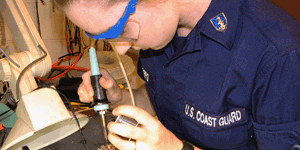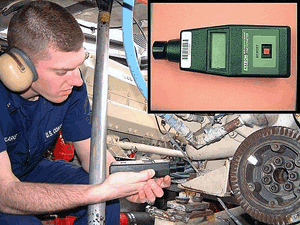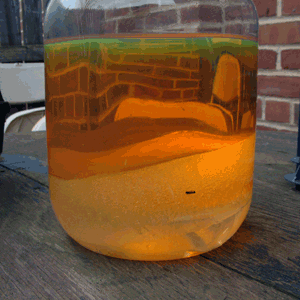Embarking on Biodiesel




June 1, 2005
BY Jessica Williams
The U.S. Coast Guard fleet contains 1,400 boats-classified as under 65 feet long-many of which are potential biodiesel users. Recognizing the many benefits of the renewable fuel, the Coast Guard's Office of Naval Engineering decided an in-depth feasibility study should be conducted before any biodiesel was used. If positive results were proven, the Coast Guard could likely implement biodiesel into its marine vessels.
The research project, conducted by the Coast Guard Academy in New London, Conn., began in winter 2004. It started as a single-phase project, but quickly evolved into these three phases:
1) observation of biodiesel in a controlled environment and stationary generator testing
2) small-scale boat testing with the installation of a data acquisition system (DAQ) that would monitor the fuel's performance and automatically collect data
3) implementation of biodiesel in select Coast Guard boats for everyday use
As of May, the first phase had been completed, and the second phase had begun. Although the project hadn't progressed exactly to plan, things moved forward despite the cadets' graduation ceremony May 18. Research will continue this summer.
The challenge
This year's research team consists of five mechanical engineers: Rebecca Lenberg of Tijeras, N.M.; Richard Szoka of Blanca, Colo.; Ryan Hawn of Niceville, Fla.; Michael Adams of Pasadena, Md.; and Steven Vanderlaske of Long Island, N.Y. According to Lt. Andy Goshorn, environmental division task leader at the Office of Naval Engineering, a different group of cadets will continue the project next year.
At the start of the project, the Coast Guard recognized the importance of conforming to ASTM standards, so the research group set out to focus specifically on vegetable oil-based biodiesel. However, in the first phase of the project, cadets observed soy-based biodiesel worked better in cold weather, and so it became the preferred choice of fuel.
In the first phase, the group observed biodiesel in a controlled setting-more specifically, in pickle jars. The eight jars allowed the cadets to evaluate whether the fuel would cloud or gel, react to salt water or host microorganisms. They were able to chart the fuel's evaporation rate and water content after it sat outside for a time. After gathering the preliminary information, they acquired the necessary sensors and gauges to perform preliminary tests on a diesel generator. In conclusion, the researchers found biodiesel could potentially meet the Coast Guard's alternative fuel needs, but more in-depth prototyping in the unique Coast Guard boat-operating environment was required.
To start the second phase, cadets planned to outfit a test boat-a 41-foot utility boat (UTB) nicknamed "soy boat"-with the DAQ, which would record the boat's twin-engine parameters. Each UTB engine has its own fuel tank, an ideal setup because one 400-horsepower engine can run on regular diesel while the other 400-horsepower engine runs on a B20 blend, allowing for a side-by-side comparison of both fuels' performance. "This took up a majority of the project, as the hardware and software had to be programmed," Hawn told Biodiesel Magazine. "In actuality, this stage will be an ongoing process as better, more efficient ways of using the DAQ will be discovered."
Test runs with the UTB are scheduled for this summer, Hawn said. The Coast Guard has 172 UTBs total, and the "soy boat" test subject-CG 41300-is the oldest in the fleet.
The project has fallen slightly behind schedule, as the DAQ installation took longer than expected. The DAQ was supposed to be delivered in early March, but didn't arrive until later in the month. "Being a cadet-run project, there was a learning curve for all involved in determining what type of data acquisition system was required, purchasing all necessary sensors and configuring the entire package," Goshorn said.
According to John Bausch, mechanical engineering professor and principal investigator for the project, the research group has ordered 500 gallons of B20 to start second-phase testing. Merlin Petroleum Co. Inc. of Westport, Conn., is the group's supplier. In addition, company representative Adrian Little personally visited the Coast Guard Academy and certified its biodiesel storage system. "He was a very helpful, forward-thinking man," Bausch said, explaining why the Coast Guard Academy chose to work with Little's company.
After graduation, the research group plans to conduct 1,000 hours of engine testing over a one-year period, long enough to observe biodiesel's performance through a cold weather cycle. The boat is scheduled to run through different tasks-search and rescue or towing, for example-in order to gather the most extensive information. The DAQ is set to collect data automatically with the help of three different classes of sensors. According to Bausch, the engine performance sensors are most important, including the global positioning system (GPS).
The GPS can track where the boat has traveled and at what speed. It can also track altitude, indicating whether the boat has to go through a rough or smooth sea. The environmental sensors will measure outboard biodiesel effects. A torque sensor, placed directly on the engine shaft, will record how many rotations the shaft makes, calculating how much fuel is being used and the amount of torque that results.
Bausch said one of the goals of the project is to show that no engine modification is needed to use biodiesel. He feels this is the first full-scale trial of biodiesel use that incorporates this amount of technology. Because the Office of Naval Engineering is only responsible for establishing policy for Coast Guard marine vessels, shoreside use of biodiesel is dependent on a variety of other factors, but the U.S. military still has a strong precedent in using the renewable fuel. Goshorn said exposure from the marine use of biodiesel might also generate interest and demand for shoreside use as well. Bausch also hopes that some of the Coast Guard's 24 cutters-vessels ranging from 65 to 420 feet and equipped for crew to live onboard-could be using biodiesel in the future.
The third phase is slated to start in 2006. In addition to implementing biodiesel in Coast Guard boats for everyday use, the group will address infrastructure issues, such as where to obtain the fuel and how much it will cost, and environmental issues, such as fuel stability, microbial growth and climate impact.
In addition to the Coast Guard Office of Naval Engineering Environmental Division, the Coast Guard Academy Mechanical Engineering section and the Coast Guard Academy waterfront division have contributed to this project, which has received vital funding and support from the Coast Guard's Office of Resource Management-Financial Analysis Division and the Coast Guard's Engineering Logistics Center.
So far, the project has been a learning experience for all parties involved. "The cadets learned firsthand about setting realistic and aggressive timelines," Goshorn said. "They learned that if something can go wrong, it will go wrong, right before you are ready to get underway for sea trials. I think the biggest challenge … was shifting their knowledge from paper to actual real-world parts and machines.
Theories, formulas and calculations that were performed on paper in the classroom didn't always hold up when faced with hidden electrical grounds, broken parts and long lead time of equipment."
Hawn agreed. "We've discovered yet again an ongoing truth about projects-they take longer than any timeline we ever set up, especially when you do not understand the scope of what you have to do" he said. "I think … the scope of the project is realized-and it definitely is more than a semester's worth of work. Fortunately, it will be carried over the summer and on into next year. This is a very Coast Guard-applicable project, and I am proud to have been a major part in it."
For more information about the academy's biodiesel research project, contact Goshorn at (202) 267-2003.
Jessica Williams is associate editor of Biodiesel Magazine. Reach her by e-mail at jwilliams@bbibiofuels.com or by phone at (701) 746-8385.
The research project, conducted by the Coast Guard Academy in New London, Conn., began in winter 2004. It started as a single-phase project, but quickly evolved into these three phases:
1) observation of biodiesel in a controlled environment and stationary generator testing
2) small-scale boat testing with the installation of a data acquisition system (DAQ) that would monitor the fuel's performance and automatically collect data
3) implementation of biodiesel in select Coast Guard boats for everyday use
As of May, the first phase had been completed, and the second phase had begun. Although the project hadn't progressed exactly to plan, things moved forward despite the cadets' graduation ceremony May 18. Research will continue this summer.
The challenge
This year's research team consists of five mechanical engineers: Rebecca Lenberg of Tijeras, N.M.; Richard Szoka of Blanca, Colo.; Ryan Hawn of Niceville, Fla.; Michael Adams of Pasadena, Md.; and Steven Vanderlaske of Long Island, N.Y. According to Lt. Andy Goshorn, environmental division task leader at the Office of Naval Engineering, a different group of cadets will continue the project next year.
At the start of the project, the Coast Guard recognized the importance of conforming to ASTM standards, so the research group set out to focus specifically on vegetable oil-based biodiesel. However, in the first phase of the project, cadets observed soy-based biodiesel worked better in cold weather, and so it became the preferred choice of fuel.
In the first phase, the group observed biodiesel in a controlled setting-more specifically, in pickle jars. The eight jars allowed the cadets to evaluate whether the fuel would cloud or gel, react to salt water or host microorganisms. They were able to chart the fuel's evaporation rate and water content after it sat outside for a time. After gathering the preliminary information, they acquired the necessary sensors and gauges to perform preliminary tests on a diesel generator. In conclusion, the researchers found biodiesel could potentially meet the Coast Guard's alternative fuel needs, but more in-depth prototyping in the unique Coast Guard boat-operating environment was required.
To start the second phase, cadets planned to outfit a test boat-a 41-foot utility boat (UTB) nicknamed "soy boat"-with the DAQ, which would record the boat's twin-engine parameters. Each UTB engine has its own fuel tank, an ideal setup because one 400-horsepower engine can run on regular diesel while the other 400-horsepower engine runs on a B20 blend, allowing for a side-by-side comparison of both fuels' performance. "This took up a majority of the project, as the hardware and software had to be programmed," Hawn told Biodiesel Magazine. "In actuality, this stage will be an ongoing process as better, more efficient ways of using the DAQ will be discovered."
Test runs with the UTB are scheduled for this summer, Hawn said. The Coast Guard has 172 UTBs total, and the "soy boat" test subject-CG 41300-is the oldest in the fleet.
The project has fallen slightly behind schedule, as the DAQ installation took longer than expected. The DAQ was supposed to be delivered in early March, but didn't arrive until later in the month. "Being a cadet-run project, there was a learning curve for all involved in determining what type of data acquisition system was required, purchasing all necessary sensors and configuring the entire package," Goshorn said.
According to John Bausch, mechanical engineering professor and principal investigator for the project, the research group has ordered 500 gallons of B20 to start second-phase testing. Merlin Petroleum Co. Inc. of Westport, Conn., is the group's supplier. In addition, company representative Adrian Little personally visited the Coast Guard Academy and certified its biodiesel storage system. "He was a very helpful, forward-thinking man," Bausch said, explaining why the Coast Guard Academy chose to work with Little's company.
After graduation, the research group plans to conduct 1,000 hours of engine testing over a one-year period, long enough to observe biodiesel's performance through a cold weather cycle. The boat is scheduled to run through different tasks-search and rescue or towing, for example-in order to gather the most extensive information. The DAQ is set to collect data automatically with the help of three different classes of sensors. According to Bausch, the engine performance sensors are most important, including the global positioning system (GPS).
The GPS can track where the boat has traveled and at what speed. It can also track altitude, indicating whether the boat has to go through a rough or smooth sea. The environmental sensors will measure outboard biodiesel effects. A torque sensor, placed directly on the engine shaft, will record how many rotations the shaft makes, calculating how much fuel is being used and the amount of torque that results.
Bausch said one of the goals of the project is to show that no engine modification is needed to use biodiesel. He feels this is the first full-scale trial of biodiesel use that incorporates this amount of technology. Because the Office of Naval Engineering is only responsible for establishing policy for Coast Guard marine vessels, shoreside use of biodiesel is dependent on a variety of other factors, but the U.S. military still has a strong precedent in using the renewable fuel. Goshorn said exposure from the marine use of biodiesel might also generate interest and demand for shoreside use as well. Bausch also hopes that some of the Coast Guard's 24 cutters-vessels ranging from 65 to 420 feet and equipped for crew to live onboard-could be using biodiesel in the future.
The third phase is slated to start in 2006. In addition to implementing biodiesel in Coast Guard boats for everyday use, the group will address infrastructure issues, such as where to obtain the fuel and how much it will cost, and environmental issues, such as fuel stability, microbial growth and climate impact.
In addition to the Coast Guard Office of Naval Engineering Environmental Division, the Coast Guard Academy Mechanical Engineering section and the Coast Guard Academy waterfront division have contributed to this project, which has received vital funding and support from the Coast Guard's Office of Resource Management-Financial Analysis Division and the Coast Guard's Engineering Logistics Center.
So far, the project has been a learning experience for all parties involved. "The cadets learned firsthand about setting realistic and aggressive timelines," Goshorn said. "They learned that if something can go wrong, it will go wrong, right before you are ready to get underway for sea trials. I think the biggest challenge … was shifting their knowledge from paper to actual real-world parts and machines.
Theories, formulas and calculations that were performed on paper in the classroom didn't always hold up when faced with hidden electrical grounds, broken parts and long lead time of equipment."
Hawn agreed. "We've discovered yet again an ongoing truth about projects-they take longer than any timeline we ever set up, especially when you do not understand the scope of what you have to do" he said. "I think … the scope of the project is realized-and it definitely is more than a semester's worth of work. Fortunately, it will be carried over the summer and on into next year. This is a very Coast Guard-applicable project, and I am proud to have been a major part in it."
For more information about the academy's biodiesel research project, contact Goshorn at (202) 267-2003.
Jessica Williams is associate editor of Biodiesel Magazine. Reach her by e-mail at jwilliams@bbibiofuels.com or by phone at (701) 746-8385.
Advertisement
Advertisement
Advertisement
Advertisement
Upcoming Events





